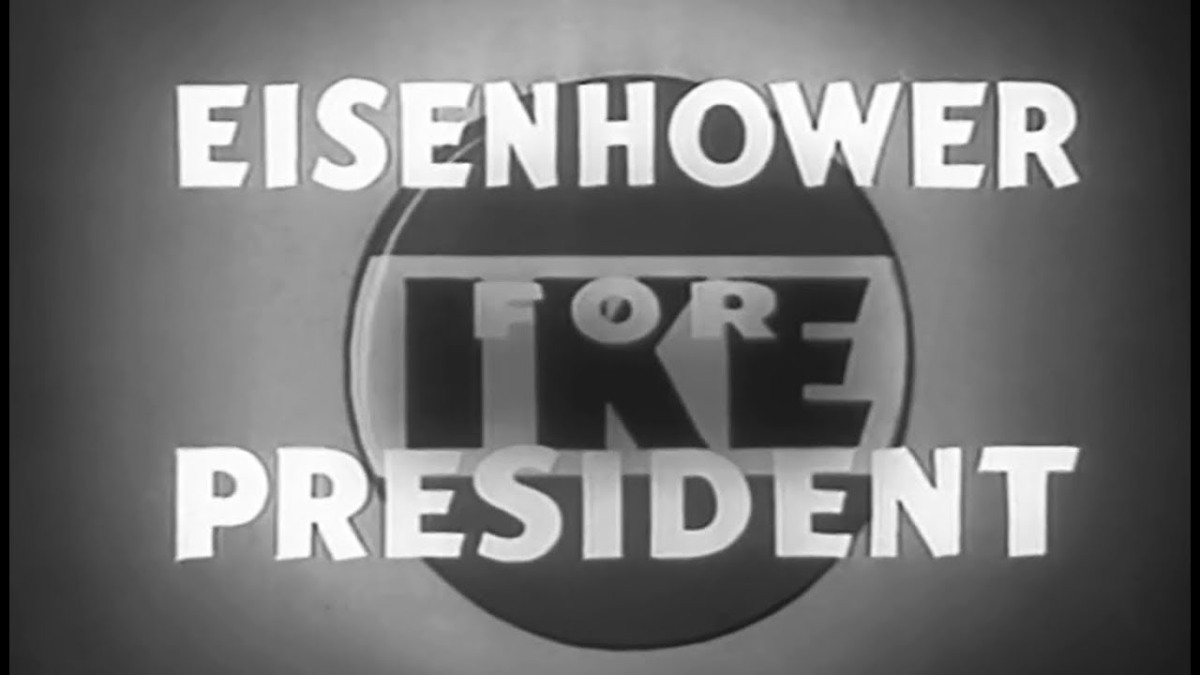By Kaleena Fraga
‘Tis the season! The presidential campaign of 2020 is in full swing. That means—especially for you swing staters—political ads will soon be hard to avoid.
So what were the best campaign ads? What were the most controversial? We’ve come up with this list of the 8 most iconic campaign ads. Here, you can explore the irresistible jingle of I Like Ike (1952) as well as the highly controversial Willie Horton ad (1988).
#1: “I Like Ike!” (1952)
Can we bring back the political jingle? There’s tons of charm in this 1952 animated advert, which endorses Dwight D. Eisenhower over Adlai Stevenson.
The ad targets Adlai Stevenson as well other prominent Democrats of the day. Stevenson is shown riding a donkey to the left (while everyone marches to the right) as the jingle chimes: “Let Adlai go the other way.”

The ad also sings, “We don’t want John or Dean or Harry” over an animation of three donkeys. This is a reference to John Sparkman, Stevenson’s running mate, Dean Acheson, the Secretary of State, and Harry Truman, the current president.

#2: “Daisy” (1964)
When nuclear Armageddon looms, you can say it all with only a few words. This Lyndon B. Johnson spot revolutionized political campaign ads.
Without naming Johnson’s opponent, Barry Goldwater, it reminded viewers of the stakes of the election. Remember, in 1964 Goldwater infamously declared: “Extremism in the defense of liberty is no vice. Moderation in the pursuit of justice is no virtue.”
Political attack ads were nothing new. But, as The Smithsonian notes, “In nearly every case…the attacks were rational, fact-based arguments.” The “Daisy” ad changed the game by playing to the viewer’s emotions instead.
#3: “Morning in America” (1984)
This simple, effective ad spoke to Ronald Reagan’s optimism. But it also drew a contrast between Reagan and his predecessor, Jimmy Carter. Carter oversaw multiple crises, including stagflation, the Oil Crisis, the Olympic Boycott, and the Iran Hostage Crisis. He famously (or infamously) gave his “Crisis of Confidence” speech in 1979, acknowledge the malaise that had overtaken the country.
Compare Crisis of Confidence with Morning in America. You can see what Reagan is doing in this quietly impactful ad. And just in case you don’t make the connection, the Gipper reminds the audience, asking them, “Why would we ever want to return to where we were?”
Note: The Lincoln Project, a group of anti-Trump Republicans, put out a twist on this classic ad. Theirs, called “Mourning in America” attacks President Trump’s response to the coronavirus pandemic.
#4: “Kennedy, Kennedy, Kennedy!” (1960)
There’s a fantastic scene in Mad Men where the advertising team watches this ad—then compares it to the incredibly dry spot that Richard Nixon put out. Like the I Like Ike! ad, this Kennedy ad is fun, charming, and…impossible to get out of your head.
It captures the youth and optimism around his campaign.
(Go ahead and compare the Nixon spot, below)
What’s fascinating about these two ads is the difference. You can see how political campaigning is beginning to shift and change.
By the time Nixon ran again in 1968, he used a different ad strategy. Below, you can see that his ad is more sophisticated and more dramatic. It lacks the charm of Kennedy Kennedy Kennedy but then again, so did 1968. (And so did Nixon!)
#5: The infamous “Willie Horton” ad (1988)
The Willie Horton ad played on racial fears among white voters. Run by the George H.W. Bush campaign, it claimed to draw a distinction between Bush and his opponent, Michael Dukakis. The ad portrayed Bush as tough on crime—a real “Law and Order” type—and Dukakis as soft on crime.
Lee Atwater, George H.W. Bush’s campaign strategist, told the team, “If I can make Willie Horton a household name, we’ll win the election.”
By 1988, the days of I Like Ike and Kennedy Kennedy Kennedy ads had long disappeared.
#6: “The Man from Hope” (1992)
Four years later, Bill Clinton’s simple, hopeful message echoed more Morning in America than Willie Horton. Speaking to the camera, Clinton draws a connection between his hometown (Hope, Arkansas) and the hope he has for the country.
Interestingly, both Clinton and his opponent, George H.W. Bush relied on simple ads like Hope. They spoke to the camera. They told stories of optimism. Ads in the early 1990s seemed to forgo the charm of the 1960s and the racism of the 1980s.
Here’s one of Bush’s 1992 ads:
#7: “The McGovern Defense” (1972)
Back to Nixon! This ad came out in 1972, when Nixon ran for reelection. Sponsored by “Democrats for Nixon” this spot uses some of the creativity we saw in the 1960s—along with the soaring orchestral numbers and compelling commander-in-chief images that we’ve come to expect in political ads.
#8: “Yes We Can” (2008)
The 2008 election changed so much campaigns, especially by bringing technology to the forefront. The Barack Obama campaign used the web more than anyone else had.
So, it’s appropriate that this “Yes We Can” ad ran only online. It quickly went viral. Within a few days, the ad had over 20 million views.
—
What’s next for political ads? Tik tok? Don’t dismiss it—at least one candidate in Canada used Tik Tok to boost his campaign!




